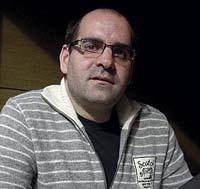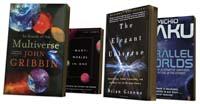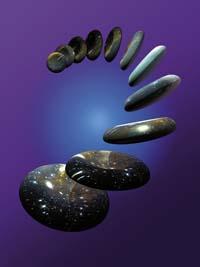In search of the multiverse

Writers and scientists invented the concept of multiservice. Those who write fiction speak of the term parallel universe, and cosmologists use the term multiverse, but ultimately it is a single concept: the idea that there is more than one universe. Physics can explain this idea or think that there is more than one universe. And perhaps that's why the concept of more than one universe came to publishers and labs.
"The origin of the idea is not clear. XIX. At the end of the H century. G. Writer Wells uses the theme of the parallel universe, though not as we understand it today. He uses the idea of fourth or fifth dimensions," says physicist Manuel Moreno, a science fiction expert at the Polytechnic University of Catalonia. "The idea was very nice for Wells. He wrote stories about contact with other worlds, living in other dimensions.
The modern idea of parallel universes emerged at Princeton University, in the thesis of physicist Hugh Everett, in 1957. In fact, it was the result of a new and heterodox interpretation of quantum physics that was not well received among the physicists of the time. Science fiction, however, appropriated immediately. "Especially in literature: Isaac Asimov, Robert Heinlein and other writers wrote stories with ideas of parallel universes. But they are written after Everett's publication," says Moreno.
Multiservice in the laboratory
Over time, Everett's ideas also spread among cosmologists. New explanations and new approaches appeared, increasing the number of physicists working on it. But not much. Multiverse research remains marginal within cosmology.
UPV cosmologist Jon Urrestilla has worked with some of the few who investigate the multi-verse and has an internal and external perspective: "Within cosmology it is very marginal. Many don't like the concept of multiverse because we don't know how much science is. But there are more and more fans. We don't know why, maybe because the theory is good, and maybe because there are people like Alex Vilenkin, Andrei Linde working on it. They are reference people. That is why there are those who think that if those great cosmologists happen something at that time. It is the influence of fame."

Inaccessible
There will be something, but what? The investigation of the multiverse is not easy. Although there is more than one universe, man only sees one, and is hardly able to recognize another universe.
"There is a limit between measurable and immediate. Hence philosophy begins. Something that cannot be measured is science?" Urrestilla asks. "According to whom you ask, he will tell you that the multiverse is not a serious science. There are three positions: there are those who say that the multiverse is not necessary to explain anything; others say yes; and then there is another third, and I believe that I am in that third, who thinks that the science of the multiverse is religion".
It is the same debate as in the prestigious talks between Niels Bohr and Albert Einstein: "Is the Moon there when we do not look at Him?" Or asking otherwise: Is there what we do not measure? Bohr said no. Einstein did. However, in the case of the multisixth, even if desired, it cannot be measured. And this excludes this concept from the realm of science. However, the concept of multiverse has been created by a scientific necessity.
"Everything comes from the problem of quantum gravitation. We do not have the theory of quantum gravitation. That's why we're doing what we can," says Urrestilla.
Quantum gravitation would unify in a single theory gravity and quantum mechanics. Gravity acts on a large scale (including galaxies, stars, planets and man). Quantum mechanics, on the other hand, on a small scale (atoms and particles smaller than the atom). Physicists want to unify both theories because all large-scale matter is made up of small-scale particles. It is logical that the theory is unique to explain everything, but there is no theory that collects gravity and quantum mechanics. However, there is a proposal: the theory of the superropes.

Atoms are formed by protons, neutrons and electrons. Neutrons and protons are made of quarkes. But what are quarks and electrons made of? The new proposal is that all particles are made of superrope. But there is a problem: the mathematics that underpin this theory requires many dimensions.
A tour of the multiverse plain
Cosmologist John Gribbin clearly exposes his book In Search of the Multiverse. The explanation is in "Three dimensions good, more dimensions bad": the superstrings must exist in a space of 11 dimensions (26 dimensional, according to another option). And the gravity in the human universe only serves a three-dimensional space. The same goes for electromagnetism and other fields of physics. If our universe had more than three dimensions, it would not have the physics it had. Therefore, for superstring theory to be useful, physicists must find the relationship between space in 11 dimensions and space in 3 dimensions (in four dimensions, including time).
"You have to go from 11 to 4 dimensions," explains Urrestilla. "And you have a lot of chances to do it, about 10 200 (one and 200 zero behind). Drawing the potential of these possibilities appears a kind of plain with many minimums. Every minimum is a possibility. And in every possibility there can be a universe. Ours is only one of those lows. These 10 200 possibilities make up the multi-verse: this is predicted by the superstring theory. Now, is the superstring theory correct? I don't know."
Communication fiction
Each minimum would have its own physics, according to the theory of the superropes. In our universe of minimum, the electron has a certain mass that can be greater or lesser in the universe at least immediately. The same with the charge of the electron; and with the constant of Planck; and with any other magnitude.

And the difference is not an empty value of a magnitude. This difference has consequences. It is possible that in another universe nuclear fission does not occur as it happens in our universe, which can result in the absence of stars. Or else carbon atoms may be different, so it is not possible to create life. And many other possibilities could be: approximately 10200.
This great set of possible physics has been a good source for science fiction. If two universes are communicated, different physicals offer fruitful stories. "One of the best known examples is the novel The Gods Themselves by the writer Isaac Asimov," says Moreno. "Aliens from another universe want to solve their energy problem by turning our Sun into a supernova and absorbing the energy it expels."
It is fiction. Impossible. Communicating two universes together, for the moment, has only made fiction. If reality were possible, scientists would have to measure. "The only option is for another universe to interact with ours. If they clashed or something like that, we could measure something," says Urrestilla. But cosmologists cannot wait. "There is something that does not interact with me, and if I cannot do anything with it, it is religion; I cannot claim it scientifically. It doesn't matter if it exists or doesn't exist, because I can never show it."
However, some cosmologists investigating the multi-verse have a positive attitude. They continue to work with theoretical models. In this sense, cosmologist Alex Vilenkin has a very special philosophy: it is worth trying, it is worth investigating multi-verses; and if that research leads to showing that the idea is wrong, it will also be good news.


Buletina
Bidali zure helbide elektronikoa eta jaso asteroko buletina zure sarrera-ontzian











